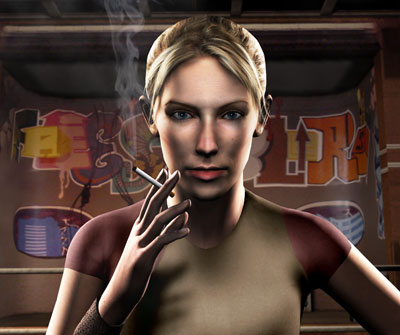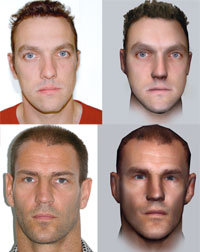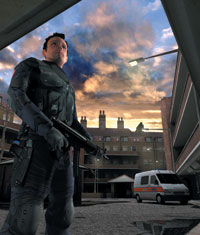GAME ENGINE: THE ART OF BONSAI FILMMAKING
Shaping the cinematic narrative of PlayStation 2’s The Getaway: Black Monday.
BY GRAHAM LEGGAT
 |
| Agile and stealthy, Sam, one of three new playable characters in PlayStation 2’s The Getaway: Black Monday. PHOTOS: SONY COMPUTER ENTERTAINMENT AMERICA. |
Two years ago, Team Soho, the London-based development studio owned by Sony Computer Entertainment Europe, released a game called The Getaway for PlayStation 2. Inspired by classic English gangster films like Get Carter, The Long Good Friday, Mona Lisa and The Italian Job, and seasoned with a dash of Guy Ritchie laddie titles Snatch and Lock, Stock and Two Smoking Barrels, the game aimed for unprecedented levels of cinematic immersion and realism. To that end the developers engaged a professional scriptwriter; cast all 30 roles, including extras; rehearsed and shot scenes on DV; and then, leaving in the voice acting, created in-game animations and cutscenes (animated mini-movies that set up the narrative, introduce background and plot twists and deliver hard-hitting climaxes) from the motion-capture data of the live action. They also shot 300,000 photographs of London streets in order to realistically map their environments and, in a radical departure from typical game conventions, did away with all the usual onscreen litter: heads-up-display items like health bars, driving maps, ammo counts, etc.
The result was interesting and flawed. The game was gritty and immersive, to be sure, with excellent dialogue, fine sound design and a sharp electronic score. It also had a film-like authenticity and attitude — in some part thanks to a smart and expensive marketing campaign but in larger part due to the deft dramatic cutscenes that occurred during and between levels. Where the game fell short was in the gameplay. Per one trade review, “In place of almost every gaming convention The Getaway boldly tries to defy, it offers a significantly worse alternative.” Despite the mixed critical reception, however, the game sold well — 1.5 million units in the U.S. and another 1.5 million worldwide — and a sequel was vouchsafed. In mid-January 2005 The Getaway: Black Monday hits the shelves.
With the new game Team Soho has remained true to its belief that, in the words of The Getaway director Brendan McNamara, “games are as culturally important as cinema.” Black Monday has been developed with the same moviemaking rigor — from the casting of professional actors to exhaustive motion-capture of their every movement and gesture — and great pains have been taken with the game’s story arcs as well as the mood and atmosphere within the scenes. But as in the first game, a significant portion of the responsibility for Black Monday’s success as a piece of cinema — or a form of cinematic narrative, at least — rests on the game’s cutscenes, which is to say, on the shoulders of lead cinematic artist Tara Saunders.
 |
| Head comparisons for Mitch (top) and Eddie (bottom ), in PlayStation 2’s The Getaway: Black Monday. |
Saunders and crew were meticulous in creating these short films. Once the script was finished and the storyboards sketched, a commercial film director was brought in to help with additional storyboarding and with the performance-direction of the cast during the shooting and motion capture. More than 90 minutes of cutscenes were created from this footage (using Alias/Kaydara Motionbuilder). After careful review, this material was edited down to the roughly 75 minutes in the finished game.
There were numerous aesthetic and technical challenges in this process. Being largely interstitial, cutscene narrative must be impressionistic, even elliptical, without being either crudely obvious or obtuse. Since processing memory has its limits, cutscenes must also be stringently economical, even draconian, in terms of numbers of characters and the nuances of their actions. (In the finished cutscene, a compressed motion-capture file is but one percent of its original size.) And because Black Monday’s cutscenes use the actual in-game sets generated by the 3-D graphics game engine, all the lighting cues are “baked” into the environments by the programmers. Unable to key-light characters at will, cutscene artists like Saunders must figure out how to wring dramatic lighting out of prelit sets.
These strictures were compounded for Saunders’s colleague Lloyd Burr, Black Monday’s senior in-game animation artist. Burr created the game’s several dozen so-called flashcuts: superfast animations inserted into the gameplay itself. Triggered at crucial moments in a level — by an explosion, say, or the unexpected stabbing of a character — these reaction shots are used to instantaneously convey key information. Often Burr was working with a chunk of memory that measured less than 20 character-seconds. That is, in a scene that took place in a room with five people present, he had less than four seconds to say his peace. As a result, often the first directorial choice, or sacrifice, was depth of field (or, rather, its encoded simulacra). Those who play the game will see that Burr’s camera angles are typically wider than Saunders’s.
 |  |
| The finished characters Mitch, left, and Eddie, right,
in PlayStation 2’s The Getaway: Black Monday. | |
“In game development, the technical boundaries can be frustrating at times,” says Saunders, “but it is rewarding when you find a way around the challenges or receive a new custom-built tool that helps push the game’s graphics forward. I enjoy the complexities of game development. I get to be involved in the whole process…from working with the actors to capture the performance to the lighting and editing of scenes. If I was to work in film, I imagine that my role would be much more restricted.”
Although she revels in her work in games, Saunders often turns to films for inspiration. She and her team watched countless movies before making Black Monday, looking for swipe. For general lighting, framing and camerawork they scrutinized GoodFellas, Casino, Klute, The Limey, Out of Sight, Le Samouraï, Gangster No. 1, Marathon Man, Pulp Fiction and, interestingly, Performance and Buffalo ’66. More specifically, Saunders says, they took lighting references in the game’s van scenes from Antonia Bird’s Face; certain police-action scenes from Kathryn Bigelow’s Point Break; police questioning from Brad Pitt’s grilling in Thelma & Louise; a torture scene from the one Mark Wahlberg endures in Three Kings; and a final showdown from Marathon Man, where Dustin Hoffman confronts nemesis Laurence Olivier (“Der Weisse Engel!”), Nazi angel of death.
Saunders’s professional relationship to cinema goes beyond intense sampling, though. Between making the first Getaway game and Black Monday, she cast around for a university course that would teach her more about the fundamentals and subtleties of filmmaking. Finding nothing, she organized one herself: Cinematography for Gamers, which was offered last year at St. Martin’s College in London. (Numerous American colleges now offer game-related courses, among them University of Michigan, Cornell, U.C. Irvine and Carnegie Mellon.)
The course was taught in five modules. The first introduced the essentials of the medium: composition, framing, set design, lighting, shot selection, editing, pacing and narrative. Modules 2 and 3 involved previsualization of various scenarios through storyboarding; the creation in Maya of blockomatics, or 3-D renderings of character locations and movements; and experimentation with lenses, focus, depth of field, camera angles and movements, film stock, etc. Module 4 discussed the direction of actors and included actual filming and motion capture of rehearsals and scenes. And Module 5 saw the presentation of footage filmed in Module 4 and edited in Premiere or Final Cut Pro and the comparison of this finished product with the original storyboards and blockomatics.
“There is a vast difference between CGI work and actual live-action movies, but the grammar and theory are similar,” said Saunders. “I wanted the course to fill in the gap between the two forms and find a sort of common language.” Likewise, there is a vast difference between Get Carter and The Long Good Friday and The Getaway: Black Monday. But increasingly there is less of a gap and more of a common language.
Asked, respectfully, to what extent she considers herself a filmmaker, Saunders replied, “The term ‘filmmaker’ describes someone who directs and produces…a connected cinematic narrative. I think what we do definitely qualifies as filmmaking. At the end of the day we are taking a script that is performed by a cast of actors, filming it (though not in the conventional sense) and telling a story. …The only real difference is the hardware that the end image is projected or rendered on.”
For more information, including making-of material narrated by Terence Stamp, go to www.blackmonday.co.uk.
VOD CALENDAR


 See the VOD Calendar →
See the VOD Calendar →


